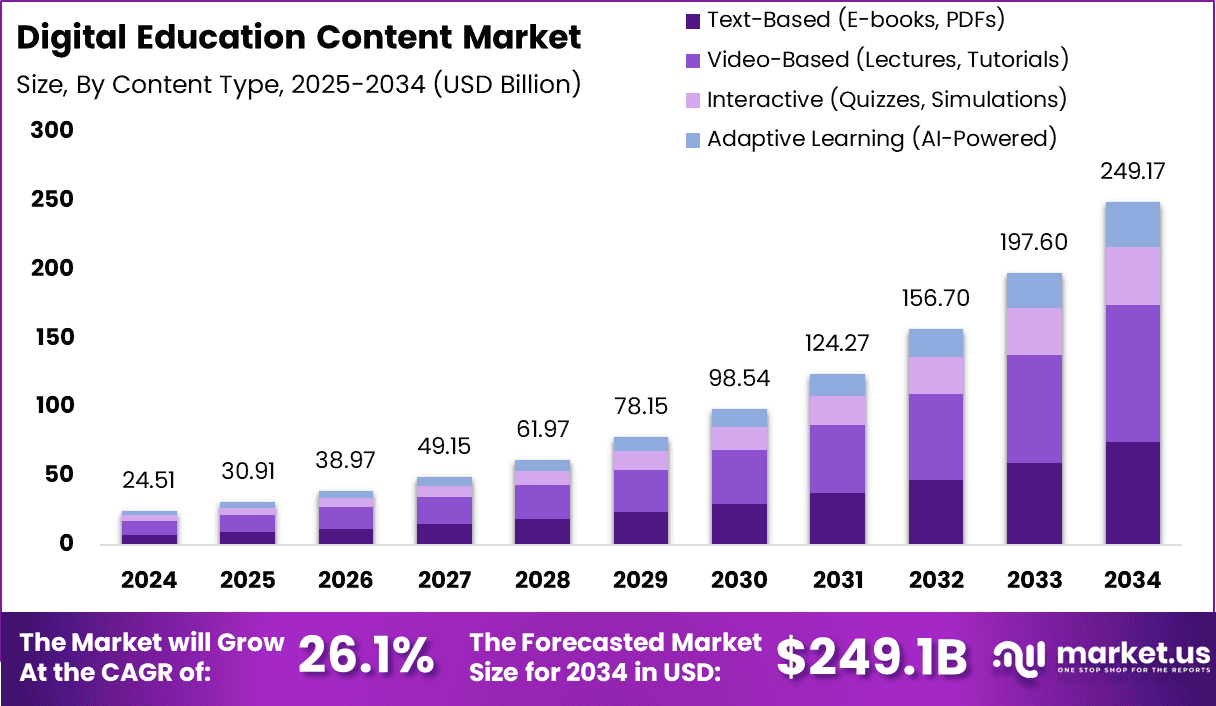Table of Contents
The Global Digital Education Content Market is expected to grow from USD 24.51 billion in 2024 to USD 249.17 billion by 2034, at a robust CAGR of 26.1%. North America, accounting for over 35% of the market share in 2024, led the global market, with the U.S. representing a significant portion at USD 8.1 billion.
This market growth is driven by the rising demand for online learning across all age groups and educational sectors, particularly in video-based learning, which holds more than 40% of the share.

How Tariffs are Impacting the Economy
Tariffs have far-reaching effects on the economy by increasing the cost of imported goods. This raises operational costs for businesses dependent on international supply chains, leading to higher product prices. These price hikes often result in inflation, reducing consumer spending power.
As a result, manufacturers and suppliers face compressed profit margins, and in some cases, companies are forced to shift production to higher-cost regions. Additionally, tariffs often lead to retaliatory measures, further complicating trade relationships. These economic disruptions may hinder growth in industries reliant on global trade, such as tech, manufacturing, and retail.
➤ Discover how our research uncovers business opportunities @ https://market.us/report/digital-education-content-market/free-sample/
Impact on Global Businesses
Businesses across industries are witnessing rising costs due to increased tariffs on imported raw materials, which leads to higher prices for end consumers. The manufacturing sector is particularly hard-hit, with many companies shifting production to countries with lower tariff barriers. Retailers, especially those with a significant portion of imports, face higher procurement costs, which in turn affect profitability.
In the tech sector, companies are finding it more expensive to source components, such as semiconductors, leading to delays in product development. The automotive industry, reliant on a global supply chain, faces higher manufacturing costs and price hikes in vehicles, which may dampen consumer demand.
Strategies for Businesses
To mitigate the impact of tariffs, businesses must evaluate and diversify their supply chains, exploring alternative sourcing options from countries with lower tariffs. They should also consider localized production or shifting manufacturing bases to regions with favorable tariff conditions.
Additionally, companies could invest in automation and technological solutions to reduce production costs, allowing them to absorb higher import prices without passing them onto consumers. Strengthening relationships with suppliers and customers can also help businesses navigate tariff-induced challenges, ensuring continuity and flexibility in operations.
➤ Explore more strategies get full access now @ https://market.us/purchase-report/?report_id=147858
Key Takeaways
- Tariffs increase costs for businesses, particularly in manufacturing and retail.
- Rising costs due to tariffs can trigger price hikes for end consumers.
- Sectors like technology and automotive face significant supply chain disruptions.
- Diversifying supply chains and localizing production can mitigate the tariff impact.
- Investment in automation and strategic partnerships can provide a buffer against rising costs.
Analyst Viewpoint
Currently, tariffs are a challenging factor in the global economy, leading to inflationary pressures and disruptions in supply chains. However, businesses that adapt through diversification, local production, and strategic partnerships can turn this challenge into an opportunity. In the future, as global trade policies evolve, companies that have fortified their operations against tariffs may emerge stronger, benefiting from the shifting trade landscape.
Regional Analysis
North America is currently the largest market for digital education content, holding over 35% of the global share in 2024. The U.S. leads this segment, driven by strong institutional adoption of EdTech tools. Europe and the Asia-Pacific region are also seeing significant growth, driven by increasing investments in online education platforms and digital content, with countries like the UK, Germany, and India showing considerable demand for virtual learning solutions.
➤ Discover More Trending Research
- Wheeled Humanoid Robots Market
- Travel and Tourism Apps Market
- Humanoid Robots for Customer Service Market
- Financial Predictive Analytics Market
Business Opportunities
The rising adoption of digital education content presents significant opportunities for content creators, platform providers, and tech companies specializing in EdTech solutions. Key areas for growth include video-based learning, personalized education, and virtual learning environments, especially within higher education and corporate training sectors. Additionally, the expansion of K-12 online education platforms offers a fertile ground for growth, particularly in developing economies.
Key Segmentation
- By Content Format: Video-based content is the leading segment, with over 40% share in 2024, driven by the demand for interactive and visual learning tools.
- By Sector: Higher education is the largest segment, contributing over 32% of global revenue, driven by the increasing enrollment in virtual universities and upskilling platforms.
- By Region: North America holds the largest market share, with the U.S. alone accounting for the majority of the market.
Key Player Analysis
Players in the digital education content market include leading educational technology providers, content creators, and platform developers. These companies are focusing on technological advancements to provide innovative, interactive content to cater to a wide range of learners. They are also investing heavily in regional expansion and enhancing the user experience by offering personalized learning tools.
Top Key Players
- 2U Inc.
- Adobe Inc.
- Ambow Education Holding Ltd.
- Apollo Global Management Inc.
- Articulate Global Inc.
- Cambridge University Press
- Cengage Learning Holdings II Inc.
- Chegg, Inc.
- Coursera Inc.
- D2L Corp.
- Echo360 Inc.
- edX Inc.
- IXL Learning
- LinkedIn Corporation
- MPS Limited
- NIIT Ltd.
- Oxford University Press
- Pearson Plc
- Pluralsight LLC
- Others
Recent Developments
Recent developments in the digital education content market highlight a surge in video-based learning adoption. The increasing integration of AI and machine learning in education platforms is enhancing personalized learning experiences.
Conclusion
The digital education content market is set for significant growth, fueled by rising demand for online learning tools. Companies that invest in content innovation and regional expansion will be well-positioned to capture a share of this expanding market.
Discuss your needs with our analyst
Please share your requirements with more details so our analyst can check if they can solve your problem(s)



